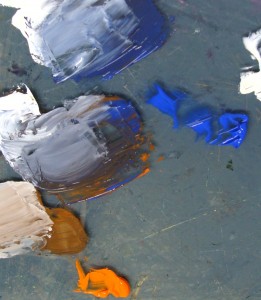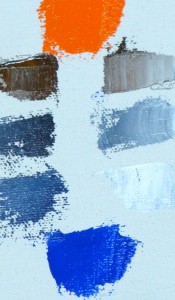Happy Halloween.
From the in-your-face intensity of traffic cones to the mellow tones of terracotta, orange affects us in vastly different ways.
Awaken your senses to orange. You’ll find saffron, brick, peach, rust, tangerine, papaya, and so much more. This is the season to look for orange variants in nature.
Today all of us will be seeing orange. Although we’ll be seeing it paired with black, its most intriguing relationship is with its complement, blue.
Placed side by side orange and blue enhance the apparent brightness of each other, but mixed together, they create grey. That’s the way it is with complements.
Assignment: Take a look at these illustrations of cadmium orange mixed with cobalt blue. Practice mixing orange with the different blues that you keep on your palette. If you don’t have orange, you can mix red and yellow to get it. Pay attention to the differences in all the mixtures. Note how they make you feel.
If you want to mute an orange , you can add blue. If you want to lower the intensity of blue, add orange.
If you just want a great grey, join these two together. You don’t need a black to get grey. You will achieve subtle and sensitive greys by using complements.
And so, when thinking of painting a sky, I generally think of orange. It works in the clear blue and in the clouds too.
- “Orange is red brought nearer to humanity by yellow.” — Wassily Kandinsky
- “Orange is the happiest color.” — Frank Sinatra
ATTENTION! The bucks are rolling in. Check them out : How Any Artist Can Make a Few Bucks Before Breakfast (Online art lesson #38)





